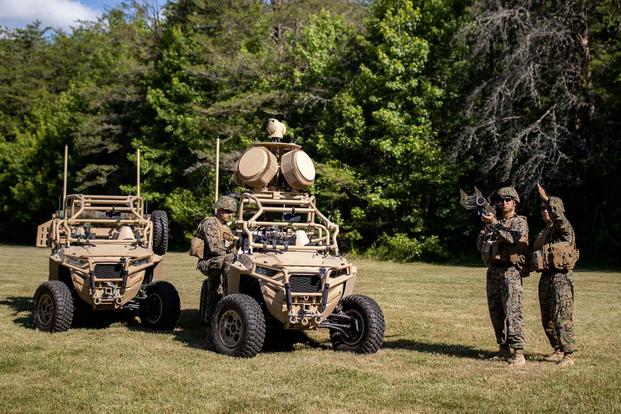The Marine Corps wants to field better counter-drone capabilities yesterday. Since that is not possible, the service says it's looking to get them to Marines right now, or at least very soon.
Over the last five years, the Marine Corps has been improving its counter-drone systems as it looks to reshape the force and compete with near-peer adversaries. Officials at Modern Day Marine, a military exposition in Washington, D.C., on Tuesday, said those efforts are paramount as competing nations such as Russia and China proliferate their own drone stocks.
"I like to say we've done great, but the enemy's got a vote," Steve Bowdren, the Marine Corps' program executive officer for land systems, told reporters Tuesday. "And so even though this has been great progress, we're almost too late, right?... It's not there today, but it's really close."
Read Next: Veterans Scammed Out of GI Bill Benefits Could Get Benefits Restored Under House-Passed Bill
Bowdren told reporters that the Marine Corps has come a long way from a half-decade ago when it "really just had Stinger" missile systems to shoot down drones. Now, it is looking at fielding upgraded systems such as the Marine Air Defense Integrated System, or MADIS, a mobile, Stinger-mounted vehicle, as well as the Medium Range Intercept Capability, or MRIC, which can target cruise missiles and drones.
Some of these systems can be expected to hit the fleet in the next year, he said.
As drones -- sometimes cheap, off-the-shelf commercial models -- stalk battlefields in Ukraine amid Russia's full-scale invasion of that country, the Marine Corps is increasing the urgency for acquiring, testing and deploying its own unmanned aerial systems, or UAS.
"Small UAS and counter-UAS are probably the biggest change that we've seen recently," Brig. Gen. Stephen Lightfoot, director of the service's Capabilities Development Directorate, said when referring to the "changing character of war."
Lightfoot pointed to the war in Ukraine as a specific data point that the Marine Corps is examining for its own counter-drone capabilities -- commercial drones, first-person-view drones, and even ones operated by cell phone are all on its radar.
Meanwhile, the service is training Marines in counter-drone tactics. As early as last week, for example, Marines with the 2nd Low Altitude Air Defense Battalion out of Camp Lejeune, North Carolina, battled single-person drones in a simulated exercise -- this time with shotguns, machine guns and rifles.
Some units, Military.com has previously reported, said that they do not have their own counter-drone capabilities, even when deploying to high-pressure regions such as the Pacific, where tensions with China are running high.
Unmanned aircraft systems are "a wicked problem that everyone's working hard to come to grips with," Col. Brendan Sullivan, then-commanding officer of Marine Rotational Force-Darwin, or MRF-D, told reporters last year. "That's a huge focus of effort within the 1st Marine Division and a specific emphasis going for the division commander."
Other units, such as the 24th Marine Expeditionary Unit, have had their hands on counter-drone systems such as the Light Marine Air Defense Integrated System, or L-MADIS, the little brother to the system with a similar name, since earlier this year. Some MEUs have used it for longer.
The threat that drones present to the Marine Corps was a concern at last year's Modern Day Marine expo, with then-commandant Gen. David Berger saying "the defense against drones and swarming drones ... it's clearly a challenge right now."
That challenge has only grown, according to officials Tuesday, and the need for the Marine Corps to thwart it is critical.
"I think it's needed right now," Lightfoot said. "[It's] easy for me to say that as a requirements guy, because I want counter-UAS yesterday."












